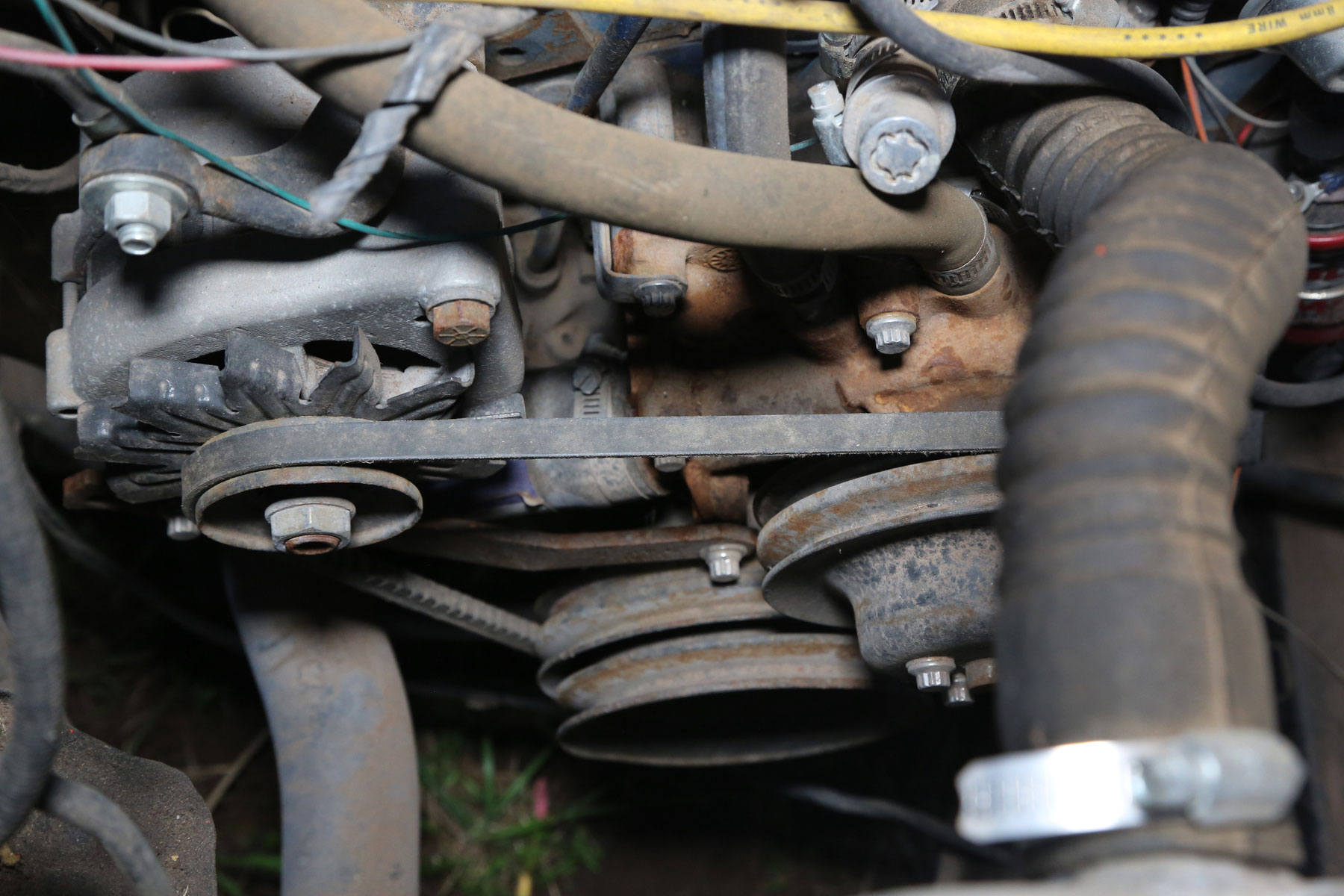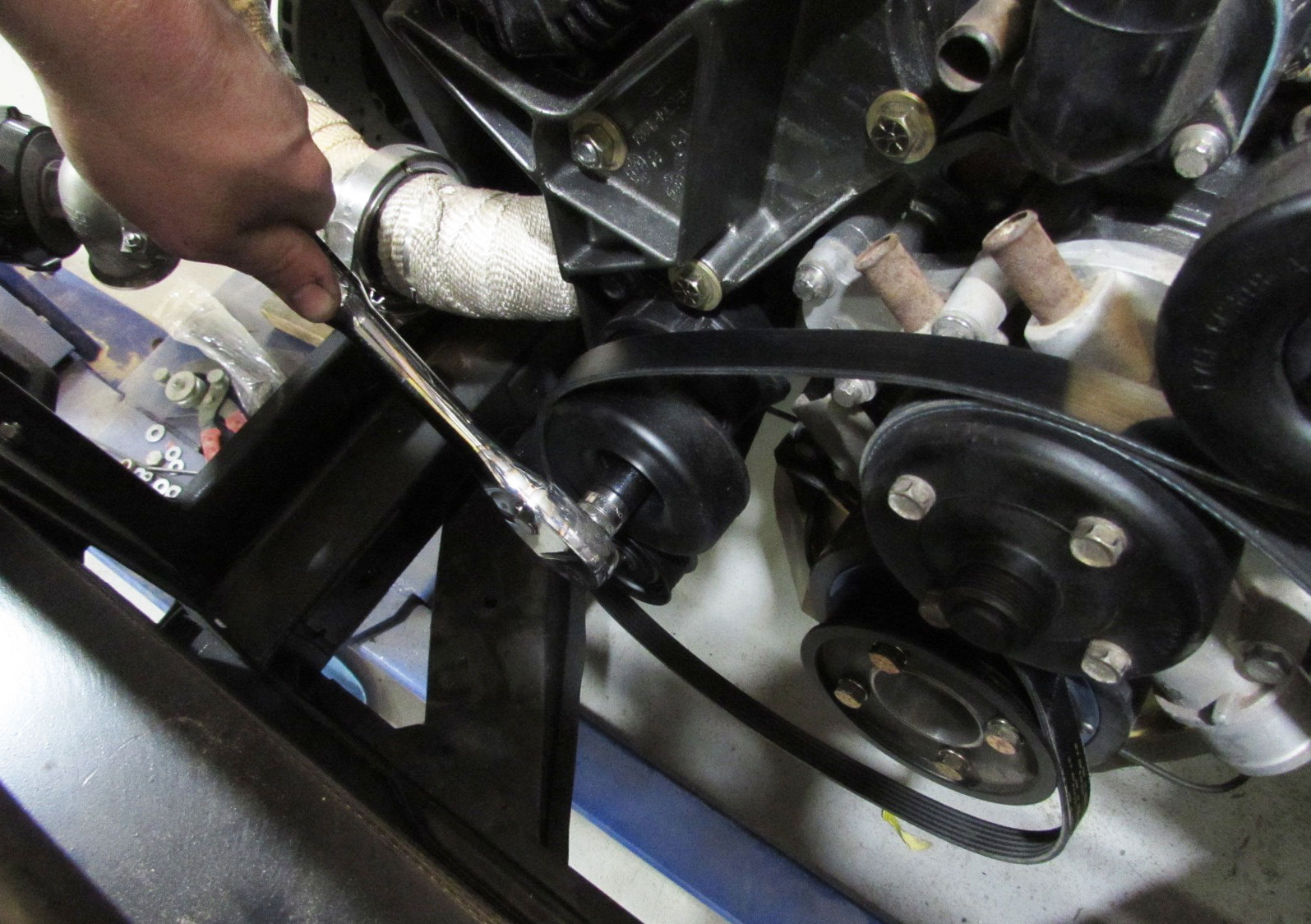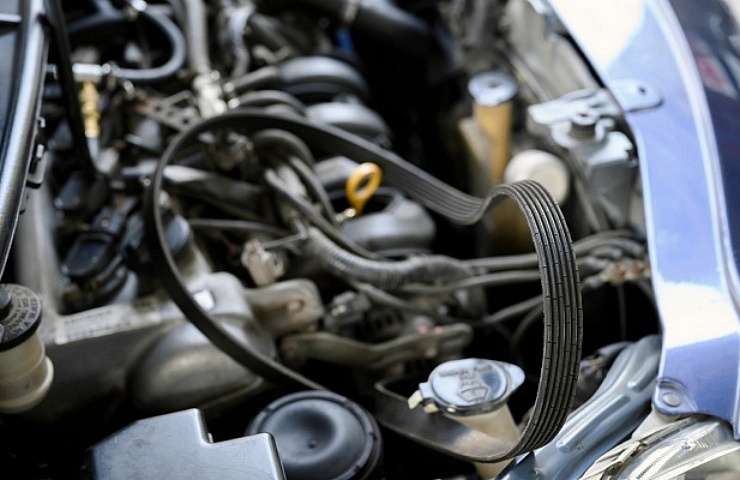Contents
The serpentine belt rides the pulleys on the front of the engine. This means it’s either toward the front of the vehicle or, if the car uses a transversely mounted engine, on the side.
Some engines use more than one belt, but it’s easier to maintain and replace the serpentine belt than those in the older V-belt systems. That’s mainly because there is only one tensioner and belt, so you don’t have to remove all the other belts to get to the one closest to the engine block.

This is a V-belt, which typically drives one or two items. These are not commonly used on modern engines.
Serpentine belts are wider, with full-length ribs that grip the pulleys better than V-belts. They make less noise, have lower friction, and last longer.
A Squealing Serpentine Belt
When a serpentine belt is failing, there are several signs that you can see and hear. The most notable is a loud squealing while the engine is running. The squeals may come and go—or remain constant. In many cases, the squeal gets louder when you rev the engine. This is a sign that the belt is slipping due to wear or a loose tensioner.
Shop now for tensionersNot all squealing is from the belt. It could be a bad bearing, a failing belt tensioner, or a worn pulley. You can test this by spraying a little lubricant on the center of each pulley while the engine is running to see if the squeal goes away.

It can be tricky to get the routing right for a serpentine belt, but it is easy to change.
If the belt appears in good shape, you can try some belt conditioner to get more life out of it. Belt conditioner is a spray that softens the rubber, making the belt more pliable and adding grip.
Signs of Serpentine Belt Wear

The ribs should be smooth, not cracked, and have a dull finish.
Physical examination of the belt may show signs of wear as well. Here are issues that call for a replacement:
Cracks – The rubber belt should be free of cracks along its length. The most common place for cracks is on the ribs. Once cracks form, sections of the rib can tear away. This is an immediate replacement situation, as the belt can fail at any point.
Frayed edges – If the edge of the belt has any loose cords or chunks of rubber missing, it needs to be replaced. Look for pulley alignment, worn or damaged pulleys, or brackets that may be touching the belt and causing the fray.
Glazing – The belt should be one uniform dull color on all sides. If the edges are shiny, there is likely an issue with a pulley or bearing allowing the belt to rub on one edge more than the other. This misalignment will wear out the belt faster. Glazing on the rib surface is a sign the belt is slipping.
Peeling – Because the belt is made of rubber, it can peel. When the belt begins to delaminate, it is near its failure point.
Wear – A belt wears out just like tires do. The ribs get thin and narrow, and the main body wears down from riding on the tensioner/idler pulleys.
Serpentine belts should be replaced every 60,000 to 100,000 miles, though it varies by manufacturer and belt maker. Cheap belts require replacement more often than high-quality belts. If the worst happens while driving, you can’t make an easy functional roadside repair to get you home. Unlike with V-belts, all the accessories run off the one belt, so you are pretty much down for the count until you can get a replacement belt.
How Much Does a Serpentine Belt Cost to Replace?
Some belts are more expensive, but the average serpentine belt costs between $50 and $100. Double-sided belts like the ones used on 2014-up GM Gen V LT-series engines can be more complicated to find and are more expensive than common single-sided belts.
For most vehicles, a belt replacement is less than an hour of labor.
How Do You Replace A Serpentine Belt?
Replacing the serpentine belt is straightforward on most vehicles. The most difficult replacement is on transverse engines, which tend to be very close to the subframe, making access to the belt difficult. But even those vehicles are a quick job.

Releasing the tensioner is the hardest part of the job. Having a helper hold the tensioner while you route the belt may be helpful.
You may need a specialty tool or long-reach wrench to release the tensioner pulley. To work on most vehicles, you can buy belt tensioner tool kits with the most common size open-end wrench fitting and square-drive ends. Most vehicles can be done with a ⅜-inch or ½-inch ratchet wrench, as they use a square-drive notch for the release on the bearing.
Shop now for tensioner tool kitsSome manufacturers require specialty tools not part of the typical kit, so check before beginning the job.
- Disconnect the battery negative terminal for safety.
- Most cars have a diagram for the belt routing on a decal under the hood, but take a picture of your routing for reference anyway.
- Locate the tensioner pulley. Connect the required tool to the tensioner and move it in the correct direction to release the belt tension away from the belt.
- Remove the belt. If you have a mechanical fan on your engine, you may have to snake the belt around it.
- This is a good time to replace the tensioner. Go ahead and unbolt the tensioner and reinstall it.
- Prep the new belt by ensuring that the ribs are on the inside.
- Install the new belt, starting with the crank pulley. Wrap the belt around each pulley as noted by the diagram. The last pulley will fit once the tensioner is released.
- The last pulley can be the tensioner itself or any easily accessible pulley; it doesn’t matter. Just ensure the belt is behind the tensioner tool before attempting to complete the installation.
- Release the tensioner and slip the last section of the belt over the pulley. Ensure the belt is fully engaged with all the pulleys’ ribs. You do not want half the belt hanging off a pulley. It will damage the belt in seconds.
- Let the tensioner move back into position, tightening the belt. Remove the tool.

The tensioner should be replaced when you replace the belt.
Replacing your serpentine belt is easy maintenance that will help keep your vehicle on the road. Besides, noisy belts are embarrassing. Do not ignore a squealing belt or a belt that shows signs of physical damage. Otherwise, you might soon be walking.





